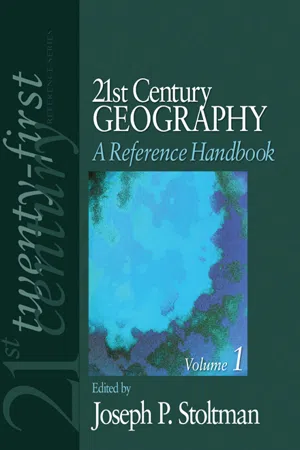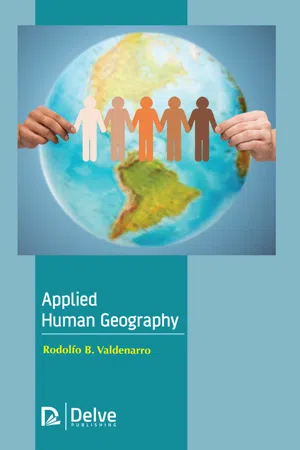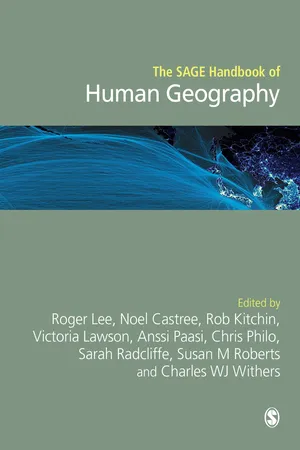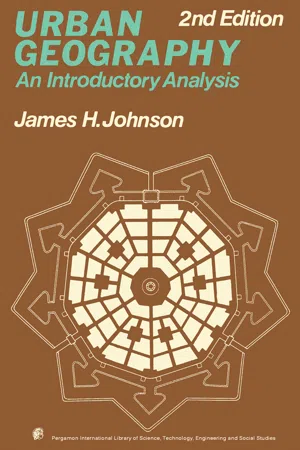Geography
Demographic Diversity
Demographic diversity refers to the variety of human characteristics and traits within a specific population or geographic area. This encompasses factors such as age, gender, ethnicity, race, religion, and socioeconomic status. Understanding demographic diversity is crucial for analyzing and addressing social, economic, and political issues within a given region.
Written by Perlego with AI-assistance
Related key terms
1 of 5
8 Key excerpts on "Demographic Diversity"
- eBook - PDF
- R. Knowles, J. Wareing(Authors)
- 2014(Publication Date)
- Made Simple(Publisher)
PART TWO : POPULATION GEOGRAPHY CHAPTER FIVE POPULATION DISTRIBUTION Until quite recently the systematic study of population had been largely neglected by geographers, in contrast with other fields of human geography such as agriculture, industry and settlement which have a long-established tradition of systematic analysis. However, in recent years there has been a growing awareness of the importance of population studies within the broad framework of human geography. Population geography has rapidly advanced from a peripheral position within the discipline to the stage where it has been claimed that 'numbers, densities and qualities of the population provide an essential background for all geography. Population is the point of reference from which all the other elements are observed and from which they all, singly and collectively, derive significance and meaning. It is population which furnishes the focus.* (G. T. Trewartha) Population geography is concerned with the study of demographic processes and their consequences in an environmental context. It may thus be distin-guished from demography by its emphasis on the spatial variations in the growth, movement and composition of populations, and its concern with the social and economic implications of these variations. The development of the subject has been severely limited by a lack of demographic data for many parts of the world, but, like other branches of geography, it is concerned with description, analysis and explanation, although a large part of the work to date has been concerned with population mapping and descriptive studies, simply in order to establish the data base which must precede analysis. Sources of Population Data One of the most difficult problems facing the population geographer is the varied quality of population data available for different countries and regions of the world. - eBook - PDF
- Joseph P. Stoltman(Author)
- 2011(Publication Date)
- SAGE Publications, Inc(Publisher)
However, geography is an integrative discipline, bringing together data, theories, methods, and research approaches from many different disciplines. Where sociologists and demographers would be interested in the causes and impacts of uneven sex ratios, population geographers might bring together the sociological and the geographical, or spatial, approach to examine the variation in the ratios at different locations to determine if the spatial pattern coincides with another variable, such as infant mortality or military conflict, that might explain the ratios. Population geographers might also consider the interaction between the human population and the natural world, which lends them special strength on issues such as the potential effects of climate change on social structures and culturally related preferences for sons. Increased economic hardship or competition for resources might have differential impacts on individual behavior in different parts of the world. Spatial demography has gained importance within sociology and demography, and the disciplinary boundar- ies between population geography and demography are increasingly blurred (Voss, 2007). Population's Role in Geography If you have ever taken a class in geography, you were likely in either a human or a physical geography course. For much of geography's history as a scholarly discipline, the physical and human components were considered inextricably inter- twined, in that each was related to the other in important ways that permitted the explanation of many events and patterns on Earth. The natural environment affected where humans decided to live, what they ate, and how their econo- mies were structured. During the past several decades of the 20th century, however, geographers often treated the human and physical components as separate halves of one disci- pline, with few linkages. - eBook - PDF
- Rodolfo B. Valdenarro(Author)
- 2019(Publication Date)
- Delve Publishing(Publisher)
With the beginning of more-sophisticated approaches, in specific those connected to GIS or remote sensing, and the ever-increasing accessibility of data at numerous spatial scales, the fundamental significance of space and geography has become more common in in the studies of the population beyond the social sciences. This development is deceptive in the expansion of a multidisciplinary subfield which is known as spatial demography that is neither outdated population geography nor classic demography. 6.7. IMPORTANT ASPECTS OF POPULATION GEOG-RAPHY The density of the population is closely connected to population distribution. This is considered as another topic in population geography. Population density studies about the average number of the individuals in the region Applied Human Geography 130 by dividing the number of the individuals present by the entire region. Generally, these numbers are given as individuals for each square kilometer or mile. There are various numbers of aspects which have the influence on the density of the population, and these are often subjects of the studies of the population geographers as well. Such type of aspects can narrate to the physical environment such as the climatic conditions and topography or be connected to the societal, economic and radical environments of the region. For instance, the regions with harsh climatic conditions such as California’s Death Valley area are sparsely occupied. In contrary to it, Tokyo and Singapore are compactly occupied because of their mild climatic conditions and their financial, societal and radical development. The entire growth of the population and the variation is another area of significance for population geographers. This is because the population of the world has increased intensely over the last two centuries. In order to study this complete subject, the growth of the population is looked at through natural rise. This studies the birth rates as well as the death rates of the region. - eBook - ePub
- Roger Lee, Noel Castree, Rob Kitchin, Vicky Lawson, Anssi Paasi, Chris Philo, Sarah Radcliffe, Susan M. Roberts, Charles Withers, Roger Lee, Noel Castree, Rob Kitchin, Vicky Lawson, Anssi Paasi, Chris Philo, Sarah Radcliffe, Susan M. Roberts, Charles Withers, Author(Authors)
- 2014(Publication Date)
- SAGE Publications Ltd(Publisher)
29 DemographiesElspeth GrahamDemography is an enormously powerful field. Its subject matter (fertility, mortality, migration, and population distribution) includes issues that are essential to social scientists who seek to understand how communities and societies function, to individuals and organisations (both public and private) who seek to change social conditions, and also to people simply interested in exploring issues that are central to their lives in society. (Riley and McCarthy, 2003: 3)The population geographer is concerned with three distinct and ascending levels of discourse: (1) the simple description of the location of population numbers and characteristics; (2) the explanation of the spatial configurations of these numbers and characteristics; and (3) the geographic analysis of population phenomena… (Zelinsky, 1966: 5–6)… a retheorized population geography must empirically and theoretically engage with the historical and contemporary disciplining and regulation of people and population through the management, administration, and control of space. (Tyner, 2009: 43)Introduction
The contemporary study that constitutes demographies is an interdisciplinary research field defined by its quest to understand, explain and predict population change. Like many areas of research, its boundaries are not strictly drawn and its potential scope is therefore extensive. Academics working in the field include demographers, economists, sociologists and social statisticians, as well as geographers, who publish their research in a wide range of population and disciplinary-specific journals. Many would question, perhaps even reject, the use of the term ‘demographies’ (in the plural) as a label for the knowledge they produce, considering it resonant of an epistemic pluralism they do not embrace. For others, concerned with the situatedness of knowledge production and circulation, ‘demographies’ will be preferred over singular labels that hint at hegemonic discourses denying the social embeddedness of research. This tension, as we shall see, is evident in the different approaches taken to the study of population change. - eBook - PDF
Urban Geography
An Introductory Analysis
- James H. Johnson, W. B. Fisher(Authors)
- 2013(Publication Date)
- Pergamon(Publisher)
C H A P T E R 3 DEMOGRAPHIC CHARACTERISTICS OF URBAN POPULATIONS THE visible landscape of the city is perhaps the most obvious object of geographical study: at least it provides a starting point for the interest of many geographers in urban areas. But associated with the morphology of any city are its past and present populations, which have adhered to certain social and economic institutions, have required to be housed, and have followed distinctive occupations. Even such a crude measure as total population has implications for the importance of a city, since this figure provides a rough indication of the size of the labour force and the nature of the specialized services which a city is likely to offer. Within any city the distribution of population as well as its total has important geographical consequences. In many cities, for instance, there is a logi-cal decrease in the density of population along a traverse from the centre to the periphery, related to the intensity of residential land use. Within certain urban areas, too, variations in the nature of the popu-lation, as well as in its quantity, have put a distinctive stamp on their various internal regions. Some characteristics of the population may be of little relevance in urban geography, since they do not affect the functional organization of the city. The average height of the population and the normal colour of eyes or of hair are examples of variations of this kind. Some characteristics are relevant only in the social and econo-mic context of particular cities: such features as the religious beliefs of different groups in the population and the distribution of ethnic groups often enter into the general functioning of life in a city and may give distinctiveness to various districts within it. Other characteristics of urban populations, however, are invariably relevant in all cities and at all times. - No longer available |Learn more
Culture and Diversity in the United States
So Many Ways to Be American
- Jack David Eller(Author)
- 2015(Publication Date)
- Routledge(Publisher)
Source: US Census Bureau. Geography DivisionNote: The full colour version of this map can be found on the companion website, www.routledge.com/cw/eller .Figure 12.4 Sex ratio (males to females) by county, 2010.Source: US Census Bureau. 2010 Census Briefs: Age and Sex CompositionNote: The full colour version of this map can be found on the companion website, www.routledge.com/cw/eller .It has already been noted that the units that we use to examine a geographic region have an influence on the results we get from our examination. At the national level, a certain statistical distribution of categories can be identified; however, at the regional or state or county or census tract level, other patterns appear. Further, as researchers agree, differences exist within areas (states, regions, etc.) just as commonalities link places across areas, and certainly the official or formal (e.g. political) boundaries on maps do not necessarily correspond to the contours of diversity across space.Probably the most common way to organize macro-level diversity within the United States is in terms of four geographical regions—Northeast, Midwest, South, and West. We have used this system in previous chapters . This is a very blunt division, though, and the US Energy Information Administration has suggested a subtler division with two or more subregions within each region, as portrayed in Figure 12.5 .But social and cultural variables cross-cut these geographic areas too, as the electoral map at the outset of the chapter illustrates, and these social/cultural characteristics do not necessarily respect international borders. This is why Joel Garreau proposed a model of regional diversity that treated all of North America as one great diversity system. “Forget about the borders dividing the United States, Canada, and Mexico, those pale barriers so thoroughly porous to money, immigrants, and ideas,” he wrote (1981: 1). Additionally, forget about “East and West, North and South, faint echoes of glorious pasts that never really existed save in sanitized textbooks” and about “the maze of state and provincial boundaries, those historical accidents and surveyor’s mistakes” (1). Instead, he offered a model of nine “nations” spread across three countries on one continent (see Figure 12.6 - eBook - PDF
- Amrita Pandey(Author)
- 2019(Publication Date)
- Delve Publishing(Publisher)
Culture and Diversity in Different Geographical Regions 7 CONTENTS 7.1. Introduction .................................................................................... 164 7.2. Importance of Understanding Cultural Diversity ............................. 165 7.3. The Culture And Diversity In North America Specially In Context of The United States .................................................... 166 7.4. The Diversity of African Culture And Creativity ............................... 168 7.5. Cultural Diversity In The Caribbean ................................................ 173 7.6. Cultural Diversity In The Central America ....................................... 174 7.7. The Culture And Diversity of Asia .................................................... 176 7.8. The Culture And Diversity of Asia In Context Of India ..................... 179 References ............................................................................................. 183 World Regional Geography 164 The culture and diversity have historically influenced the country traditions, cus -toms, languages, cuisines and everything that defines the characteristic as a nation or continent. The culture has also shaped the countries’ economies by the tourism industry. The basis of tourism is culture. The individuals want to experience the different cultures, the various archaeological sites; the different cuisines basically the cultures attract the tourist in a great manner. 7.1. INTRODUCTION The cultural diversity and cultural change are formed, maintained and lost over time. The essential aspect of the creation of cultural repertoire is societal learning and selection, acquiring and assimilating and rejecting information and knowledge. The human beings have learned the behavior has contributed to the rich human culture. The things that are included in culture are Proficiency in taking advantage of our environment, values about that matters in life are, amid other things. - eBook - PDF
- Bruce Anthony Jones, Anthony Rolle(Authors)
- 2015(Publication Date)
- Information Age Publishing(Publisher)
Toward this end, we first document the nature and mag- nitude of recent population shifts, focusing specifically on how the post-2000 great demographic disruptions have affected both the composition and geo- graphic distribution of the nation’s total and youth (<18) populations. Next, we develop a contemporary demographic profile of the <18 population and their living arrangements. We then shift our attention to one of today’s most pressing K–12 education leadership challenges: how to successfully educate young people who are geographically isolated in counties where there is in- adequate support for public education and neighborhoods where hyperseg- regation and concentrated poverty are persistent and seemingly intractable (Massey, 2007; Massey & Denton, 1993; Sharkey, 2013); a group constrained by what we characterize as the triple whammy of geographic disadvantage. We conclude with a set of recommendations regarding how school leaders might go about devising effective strategies and leveraging the requisite financial resources to overcome the triple whammy of geographic disadvantage for an estimated 9.8 million mainly Black and Latino youth. DEMOGRAPHIC DRIVERS OF CHANGE Two colorful demographic processes are profoundly changing both the com- position and complexion of America’s <18 population as well as the family, household, and geographical contexts and settings in which they live, attend school, and engage in other aspects of daily life. The first is the ‘browning” and the second is the “graying” of America (Frey, 2010; Johnson & Kasarda, 2011). The Browning of America Browning is the term used to describe changes in the racial/ethnic com- position of the U.S. population, which is occurring as a consequence of
Index pages curate the most relevant extracts from our library of academic textbooks. They’ve been created using an in-house natural language model (NLM), each adding context and meaning to key research topics.







